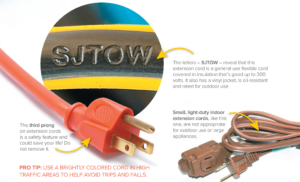Knowledge is power: Extension cord Q&A
 Q: Is it okay to use an extension cord to permanently power an electrical appliance?
Q: Is it okay to use an extension cord to permanently power an electrical appliance?
A: According to the National Electrical Code, flexible cords can’t be used as a substitute for fixed wiring. They’re designed for temporary use. Call an electrician to install an outlet instead.
Q: How are extension cords sized?
A: By the length of the cord and by wire size. Wire size is measured by wire gauge (AWG). The smaller the number, the larger the wire. A 12-gauge wire is larger than a 14-gauge wire and carries more power.
Q: What size cord do I need?
A: It should be sized to safely carry the electrical load of the device connected to it. You can find the amperage of any device by looking on the nameplate attached to it. Besides the electrical load connected to the cord, the length of the cord also plays a factor. Longer cords need to be a larger wire size to power the same device as a shorter cord. For example, an air compressor may run great on a 12-gauge cord that’s 50 feet long. That same compressor might be damaged on a 12-gauge cord that’s 100 feet long. In that case, you’d need to upsize to a 10-gauge cord.
Q: What do all those letters on extension cords mean?
A: The National Electric Code specifies characteristics for extension cords that are required to be printed approximately every foot along the wire:

Q: Is there a difference in indoor and outdoor extension cords?
A: Yes. Indoor cords have thinner protective insulation and should not be used for outdoor projects.
Q: What are some other safety tips for extension cords?
A: Don’t run cords under rugs or furniture. Don’t run cords through doors or anywhere they could be damaged. Check cords for damage before using. Don’t remove the third prong from a three-prong plug. Use a ground-fault circuit interrupter (GFCI) in damp areas.

